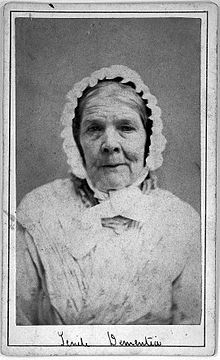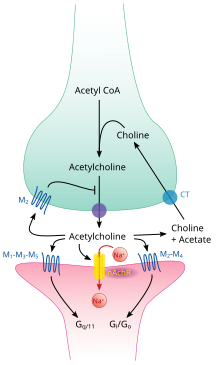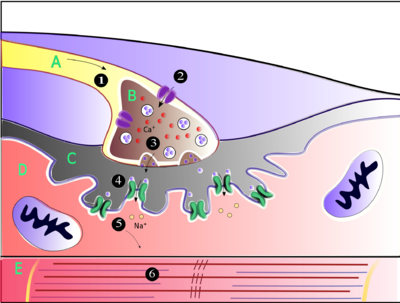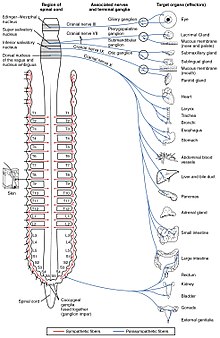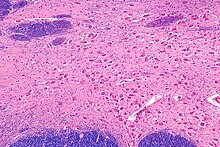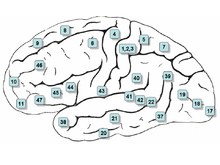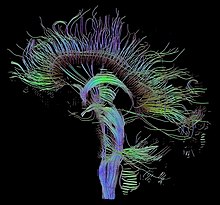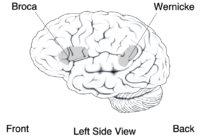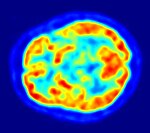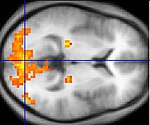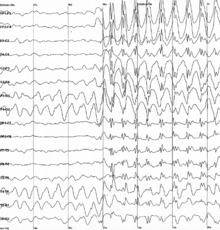Woman suffering from senile dementia
Age-related memory loss, sometimes described as "normal aging", is qualitatively different from memory loss associated with dementias such as Alzheimer's disease, and is believed to have a different brain mechanism.
Mild cognitive impairment
Mild cognitive impairment (MCI) is a condition in which people face memory problems more often than that of the average person their age. These symptoms, however, do not prevent them from carrying out normal activities and are not as severe as the symptoms for Alzheimer's disease (AD). Symptoms often include misplacing items, forgetting events or appointments, and having trouble finding words.According to recent research, MCI is seen as the transitional state between cognitive changes of normal aging and Alzheimer's disease. Several studies have indicated that individuals with MCI are at an increased risk for developing AD, ranging from 1% to 25% per year; in one study 24% of MCI patients progressed to AD in 2 years and 20% more over 3 years, whereas another study indicated that the progression of MCI subjects was 55% in 4.5 years. Some patients with MCI, however, never progress to AD.
Studies have also indicated patterns that are found in both MCI and AD. Much like patients with Alzheimer's disease, those suffering from mild cognitive impairment have difficulty accurately defining words and using them appropriately in sentences when asked. While MCI patients had a lower performance in this task than the control group, AD patients performed worse overall. The abilities of MCI patients stood out, however, due to the ability to provide examples to make up for their difficulties. AD patients failed to use any compensatory strategies and therefore exhibited the difference in use of episodic memory and executive functioning.
Normal aging
Normal aging is associated with a decline in various memory abilities in many cognitive tasks; the phenomenon is known as age-related memory impairment (AMI) or age-associated memory impairment (AAMI). The ability to encode new memories of events or facts and working memory shows decline in both cross-sectional and longitudinal studies. Studies comparing the effects of aging on episodic memory, semantic memory, short-term memory and priming find that episodic memory is especially impaired in normal aging; some types of short-term memory are also impaired. The deficits may be related to impairments seen in the ability to refresh recently processed information.Source information is one type of episodic memory that suffers with old age; this kind of knowledge includes where and when the person learned the information. Knowing the source and context of information can be extremely important in daily decision-making, so this is one way in which memory decline can affect the lives of the elderly. Therefore, reliance on political stereotypes is one way to use their knowledge about the sources when making judgments, and the use of metacognitive knowledge gains importance. This deficit may be related to declines in the ability to bind information together in memory during encoding and retrieve those associations at a later time.
Episodic memory is supported by networks spanning frontal, temporal, and parietal lobes. The interconnections in the lobes are presumed to enable distinct aspects of memory, whereas the effects of gray matter lesions have been extensively studied, less is known about the interconnecting fiber tracts. In aging, degradation of white matter structure has emerged as an important general factor, further focusing attention on the critical white matter connections.
Exercise affects many people young and old. For the young if exercise is introduced it can form a constructive habit that can be instilled throughout adulthood. For the elderly, especially those with Alzheimer’s or other diseases that affect the memory, when the brain is introduced to exercise the hippocampus part of the brain can regain in size and improve memory.
In particular, associative learning, which is another type of episodic memory, is vulnerable to the effects of aging, and this has been demonstrated across various study paradigms. This has been explained by the Associative Deficit Hypothesis (ADH), which states that aging is associated with a deficiency in creating and retrieving links between single units of information. This can include knowledge about context, events or items. The ability to bind pieces of information together with their episodic context in a coherent whole has been reduced in the elderly population. Furthermore, the older adults’ performances in free recall involved temporal contiguity to a lesser extent than for younger people, indicating that associations regarding contiguity become weaker with age.
Several reasons have been speculated as to why older adults use less effective encoding and retrieval strategies as they age. The first is the “disuse” view, which states that memory strategies are used less by older adults as they move further away from the educational system. Second is the “diminished attentional capacity” hypothesis, which means that older people engage less in self-initiated encoding due to reduced attentional capacity. The third reason is the “memory self-efficacy,” which indicates that older people do not have confidence in their own memory performances, leading to poor consequences. It is known that patients with Alzheimer’s disease and patients with semantic dementia both exhibit difficulty in tasks that involve picture naming and category fluency. This is tied to damage to their semantic network, which stores knowledge of meanings and understandings.
One phenomenon, known as "Senior Moments", is a memory deficit that appears to have a biological cause. When an older adult is interrupted while completing a task, it is likely that the original task at hand can be forgotten. Studies have shown that the brain of an older adult does not have the ability to re-engage after an interruption and continues to focus on the particular interruption unlike that of a younger brain. This inability to multi-task is normal with aging and is expected to become more apparent with the increase of older generations remaining in the work field.
A biological explanation for memory deficits in aging includes a postmortem examination of five brains of elderly people with better memory than average. These people are called the "super aged,” and it was found that these individuals had fewer fiber-like tangles of tau protein than in typical elderly brains. However, a similar amount of amyloid plaque was found.
More recent research has extended established findings of age related decline in executive functioning, by examining related cognitive processes that underlie healthy older adults’ sequential performance. Sequential performance refers to the execution of a series steps needed to complete a routine, such as the steps required to make a cup of coffee or drive a car. An important part of healthy aging involves older adults’ use of memory and inhibitory processes to carry out daily activities in a fixed order without forgetting the sequence of steps that were just completed while remembering the next step in the sequence. A recent study examined how young and older adults differ in the underlying representation of a sequence of tasks and their efficiency at retrieving the information needed to complete their routine. Findings from this study revealed that when older and young adults had to remember a sequence of 8 animal images arranged in a fixed order, both age groups spontaneously used the organizational strategy of chunking to facilitate retrieval of information. However, older adults were slower at accessing each chunk compared to younger adults, and were better able to benefit from the use of memory aids, such as verbal rehearsal to remember the order of the fixed sequence. Results from this study suggest that there are age differences in memory and inhibitory processes that affect people’s sequence of actions and the use of memory aids could facilitate the retrieval of information in older age.
Causes
Memory lapses can be both aggravating and frustrating but they are due to the overwhelming amount of information that is being taken in by the brain. Issues in memory can also be linked to several common physical and psychological causes, such as: anxiety, dehydration, depression, infections, medication side effects, poor nutrition, vitamin B12 deficiency, psychological stress, substance abuse, chronic alcoholism, thyroid imbalances, and blood clots in the brain. Taking care of your body and mind with appropriate medication, doctoral check-ups, and daily mental and physical exercise can prevent some of these memory issues.Some memory issues are due to stress, anxiety, or depression. A traumatic life event, such as the death of a spouse, can lead to changes in lifestyle and can leave an elderly person feeling unsure of themselves, sad, and lonely. Dealing with such drastic life changes can therefore leave some people confused or forgetful. While in some cases these feelings may fade, it is important to take these emotional problems seriously. By emotionally supporting a struggling relative and seeking help from a doctor or counselor, the forgetfulness can be improved.
Theories
Tests and data show that as people age, the contiguity effect weakens. This is supported by the associative deficit theory of memory, which asserts old people's poor memory performance is attributed to their difficulty in creating and retaining cohesive episodes. The supporting research in this test, after controlling for sex, education, and other health-related issues, show that greater age was associated with lower hit and greater false alarm rates, and also a more liberal bias response on recognition tests.Older people have a higher tendency to make outside intrusions during a memory test. This can be attributed to the inhibition effect. Inhibition caused participants to take longer time in recalling or recognizing an item, and also subjected the participants to make more frequent errors. For instance, in a study using metaphors as the test subject, older participants rejected correct metaphors more often than literally false statements.
Working memory, which as previously stated is a memory system that stores and manipulates information as we complete cognitive tasks, demonstrates great declines during the aging process. There have been various theories offered to explain why these changes may occur, which include fewer attentional resources, slower speed of processing, less capacity to hold information, and lack of inhibitory control. All of these theories offer strong arguments, and it is likely that the decline in working memory is due to the problems cited in all of these areas.
Some theorists argue that the capacity of working memory decreases as we age, and we are able to hold less information. In this theory, declines in working memory are described as the result of limiting the amount of information an individual can simultaneously keep active, so that a higher degree of integration and manipulation of information is not possible because the products of earlier memory processing are forgotten before the subsequent products.
Another theory that is being examined to explain age related declines in working memory is that there is a limit in attentional resources seen as we age. This means that older individuals are less capable of dividing their attention between two tasks, and thus tasks with higher attentional demands are more difficult to complete due to a reduction in mental energy. Tasks that are simple and more automatic, however, see fewer declines as we age. Working memory tasks often involve divided attention, thus they are more likely to strain the limited resources of aging individuals.
Speed of processing is another theory that has been raised to explain working memory deficits. As a result of various studies he has completed examining this topic, Salthouse argues that as we age our speed of processing information decreases significantly. It is this decrease in processing speed that is then responsible for our inability to use working memory efficiently as we age. The younger persons brain is able to obtain and process information at a quicker rate which allows for subsequent integration and manipulation needed to complete the cognitive task at hand. As this processing slows, cognitive tasks that rely on quick processing speed then become more difficult.
Finally, the theory of inhibitory control has been offered to account for decline seen in working memory. This theory examines the idea that older adults are unable to suppress irrelevant information in working memory, and thus the capacity for relevant information is subsequently limited. Less space for new stimuli due may attribute to the declines seen in an individual's working memory as they age.
As we age, deficits are seen in the ability to integrate, manipulate, and reorganize the contents of working memory in order to complete higher level cognitive tasks such as problem solving, decision making, goal setting, and planning. More research must be completed in order to determine what the exact cause of these age-related deficits in working memory are. It is likely that attention, processing speed, capacity reduction, and inhibitory control may all play a role in these age-related deficits. The brain regions that are active during working memory tasks are also being evaluated, and research has shown that different parts of the brain are activated during working memory in younger adults as compared to older adults. This suggests that younger and older adults are performing these tasks differently.
Mechanism research
A deficiency of the RbAp48 protein has been associated with age-related memory loss.In 2010, experiments that have tested for the significance of under-performance of memory for an older adult group as compared to a young adult group, hypothesized that the deficit in associate memory due to age can be linked with a physical deficit. This deficit can be explained by the inefficient processing in the medial-temporal regions. This region is important in episodic memory, which is one of the two types of long-term human memory, and it contains the hippocampi, which are crucial in creating memorial association between items.
Age-related memory loss is believed to originate in the dentate gyrus, whereas Alzheimer's is believed to originate in the entorhinal cortex.
Prevention and treatment
Various actions have been suggested to prevent memory loss or even improve memory.The Mayo Clinic has suggested seven steps: stay mentally active, socialize regularly, get organized, eat a healthy diet, include physical activity in your daily routine, and manage chronic conditions. Because some of the causes of memory loss include medications, stress, depression, heart disease, alcohol abuse, thyroid problems, vitamin B12 deficiency, not drinking enough water, and not eating nutritiously, fixing those problems could be a simple, effective way to slow down dementia. Some say that exercise is the best way to prevent memory problems, because that would increase blood flow to the brain and perhaps help new brain cells grow.
The treatment will depend on the cause of memory loss, but various drugs to treat Alzheimer’s disease have been suggested in recent years. There are four drugs currently approved by the FDA for the treatment of Alzheimer’s, and they all act on the cholinergic system: Donepezil, Galantamine, Rivastigmine, and Tacrine. Although these medications are not the cure for Alzheimer’s, symptoms may be reduced for up to eighteen months for mild or moderate dementia. These drugs do not forestall the ultimate decline to full Alzheimer's.
Also, modality is important in determining the strength of the memory. For instance, auditory creates stronger memory abilities than visual. This is shown by the higher recency and primacy effects of an auditory recall test compared to that of a visual test. Research has shown that auditory training, through instrumental musical activity or practice, can help preserve memory abilities as one ages. Specifically, in Hanna-Pladdy and McKay's experiment, they tested and found that the number of years of musical training, all things equal, leads to a better performance in non-verbal memory and increases the life span on cognition abilities in one's advanced years.
Caregiving
By keeping the patient active, focusing on their positive abilities, and avoiding stress, these tasks can easily be accomplished. Routines for bathing and dressing must be organized in a way so that the patient still feels a sense of independence. Simple approaches such as finding clothes with large buttons, elastic waist bands, or Velcro straps can ease the struggles of getting dressed in the morning. Further, finances must be managed. Changing passwords to prevent over-use and involving a trusted family member or friend in managing accounts can prevent financial issues. When household chores begin to pile up, find ways to break down large tasks into small, manageable steps that can be rewarded. Finally, talking with and visiting a family member or friend with memory issues is very important. Using a respectful and simple approach, talking one-on-one can ease the pain of social isolation and bring much mental stimulation.Domains of memory spared vs. affected
In contrast, implicit, or procedural memory, typically shows no decline with age. Other types of short-term memory show little decline, and semantic knowledge (e.g. vocabulary) actually improves with age. In addition, the enhancement seen in memory for emotional events is also maintained with age.Losing working memory has been cited as being the primary reason for a decline in a variety of cognitive tasks due to aging. These tasks include long-term memory, problem solving, decision making, and language. Working memory involves the manipulation of information that is being obtained, and then using this information to complete a task. For example, the ability of one to recite numbers they have just been given backwards requires working memory, rather than just simple rehearsal of the numbers which would require only short-term memory. One's ability to tap into one's working memory declines as the aging process progresses. It has been seen that the more complex a task is, the more difficulty the aging person has with completing this task. Active reorganization and manipulation of information becomes increasingly harder as adults age. When an older individual is completing a task, such as having a conversation or doing work, they are using their working memory to help them complete this task. As they age, their ability to multi-task seems to decline; thus after an interruption it is often more difficult for an aging individual to successfully finish the task at hand. Additionally, working memory plays a role in the comprehension and production of speech. There is often a decline in sentence comprehension and sentence production as individuals age. Rather than linking this decline directly to deficits in linguistic ability, it is actually deficits in working memory that contribute to these decreasing language skills.
